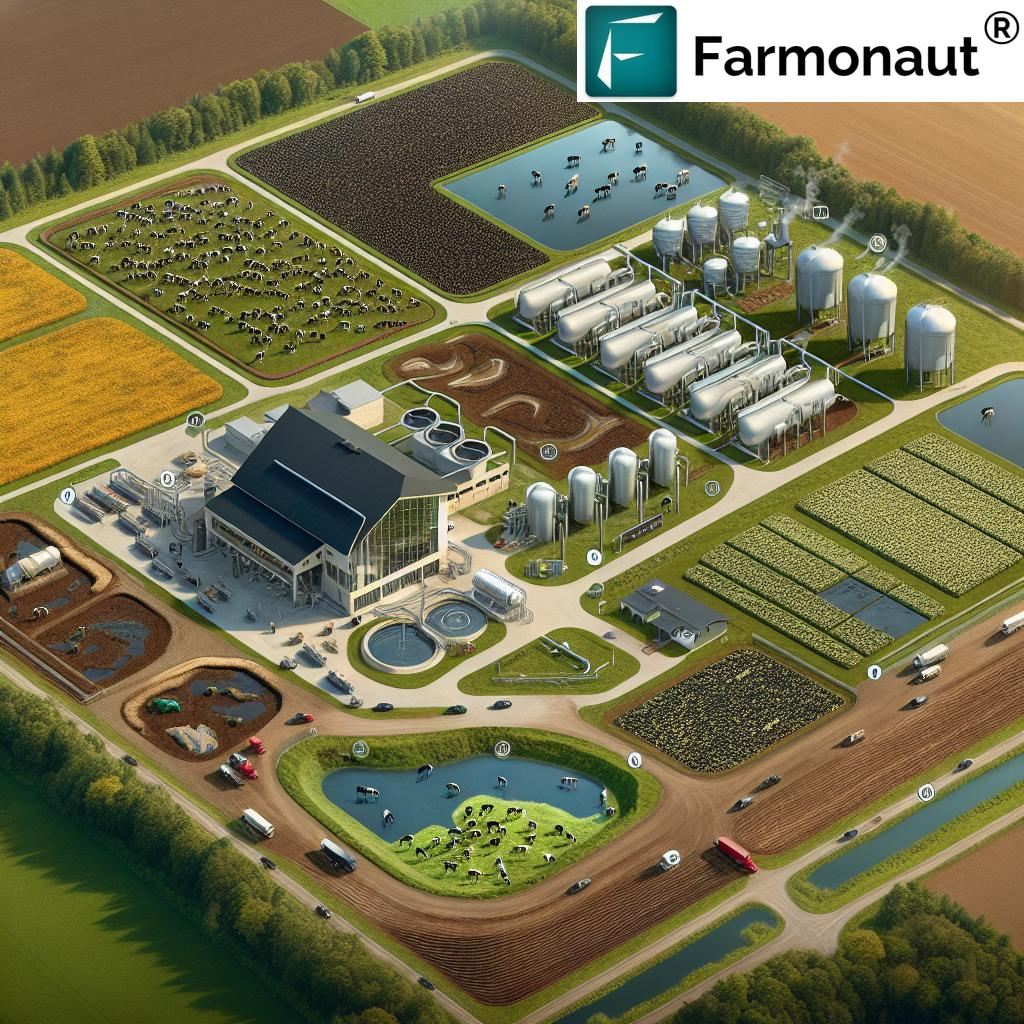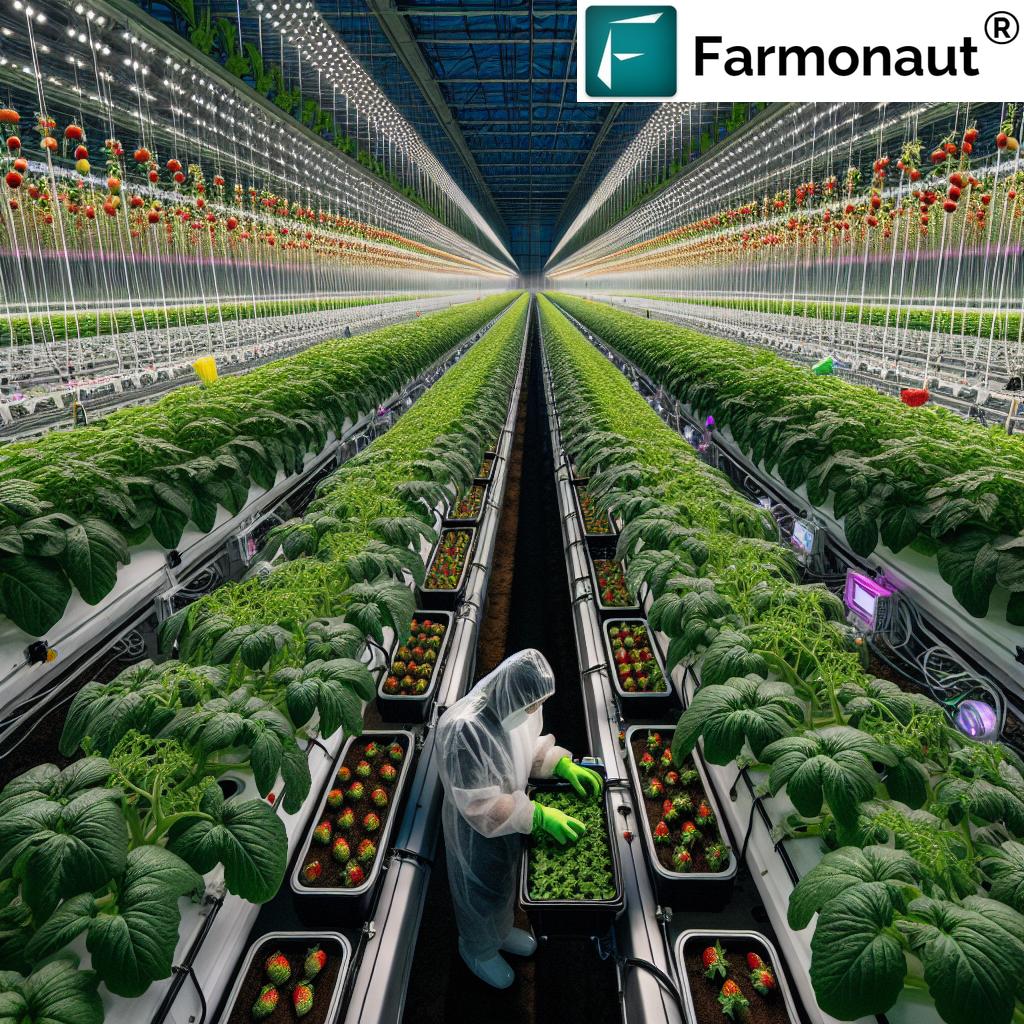Canadian Dairy Farmers: Pioneering Sustainable Agriculture and Net-Zero Emissions by 2050
“Canadian dairy farmers aim to achieve net-zero emissions by 2050, pioneering sustainable agriculture on a national scale.”
Welcome to our comprehensive exploration of sustainable dairy farming in Canada. As we delve into this topic, we’ll uncover how Canadian dairy farmers are at the forefront of agricultural innovation, committed to achieving net-zero emissions by 2050. Our journey will take us through the landscapes of provinces like Alberta (AB), British Columbia (BC), Manitoba (MB), and beyond, showcasing how farmers across the country are embracing regenerative farming practices to enhance soil health, improve biodiversity, and reduce their environmental footprint.
In this blog post, we’ll discover the cutting-edge techniques used in milk production, from advanced animal health protocols to stringent quality and safety standards. We’ll learn about the industry’s dedication to sustainability through initiatives like agricultural plastic recycling and water conservation. Join us as we explore the latest research driving improvements in nutrition, herd management, and environmental stewardship.
Gain insights into how Canadian dairy farmers are adapting to climate change challenges while maintaining high standards of animal welfare and food safety. We’ll also uncover the role of education in promoting dairy nutrition and fostering a new generation of sustainable agriculture practitioners. Read on to explore how Canadian dairy farms are shaping the future of sustainable food production.

The Landscape of Canadian Dairy Farming
Canadian dairy farming is a cornerstone of our nation’s agricultural sector, spanning from the rolling hills of Nova Scotia (NS) to the fertile valleys of British Columbia (BC). Our dairy industry is characterized by its commitment to sustainability, innovation, and high-quality milk production. Let’s take a closer look at the current state of dairy farming in Canada and its significance to our economy and environment.
- Regional Diversity: Dairy farms can be found in every province, from Quebec (QC) to Saskatchewan (SK), each adapting to local climates and conditions.
- Farm Sizes: Canadian dairy farms range from small family-operated businesses to larger commercial operations, all contributing to the nation’s milk supply.
- Economic Impact: The dairy industry is a significant contributor to Canada’s GDP, providing jobs and supporting rural communities across the country.
- Product Variety: Beyond fluid milk, Canadian dairy farmers produce a wide range of products including cheese, yogurt, and butter, catering to diverse consumer preferences.
As we move forward, it’s crucial to understand how these farms are adapting to the challenges of climate change and embracing sustainable practices. The journey towards net-zero emissions is not just an environmental imperative but also a path to ensuring the long-term viability of Canadian dairy farming.
Embracing Regenerative Farming Practices
At the heart of sustainable dairy farming in Canada is the adoption of regenerative agriculture techniques. These practices go beyond sustainability, aiming to actively improve the environment while producing high-quality dairy products. Let’s explore some of the key regenerative farming practices being implemented across Canadian dairy farms:
- Cover Cropping: Planting cover crops between dairy cow feed crops to improve soil health and prevent erosion.
- Rotational Grazing: Implementing strategic grazing patterns to promote pasture recovery and enhance soil carbon sequestration.
- Reduced Tillage: Minimizing soil disturbance to maintain soil structure and promote beneficial microbial activity.
- Agroforestry: Integrating trees and shrubs into dairy farming landscapes to improve biodiversity and provide additional ecosystem services.
These practices not only contribute to soil health improvement techniques but also play a crucial role in enhancing biodiversity on dairy farms. By fostering a more diverse ecosystem, Canadian dairy farmers are creating resilient agricultural systems that can better withstand environmental stresses and contribute to carbon sequestration.
Explore Farmonaut’s innovative solutions for sustainable agriculture:
Advanced Animal Health Protocols
The health and well-being of dairy cows are paramount in Canadian agriculture innovation. Advanced animal health protocols are being implemented across farms to ensure the highest standards of care while contributing to the overall goal of sustainable dairy farming. These protocols include:
- Precision Nutrition: Tailoring feed rations to meet the specific nutritional needs of each cow, optimizing health and milk production while reducing waste.
- Regular Health Monitoring: Utilizing technology like wearable sensors to track cow health metrics in real-time, allowing for early intervention when needed.
- Improved Housing Systems: Designing cow barns with comfort in mind, including features like rubber flooring and advanced ventilation systems to reduce stress and promote natural behaviors.
- Selective Breeding: Focusing on traits that improve cow longevity, health, and efficiency, which in turn reduces the environmental impact per unit of milk produced.
By prioritizing animal health, Canadian dairy farmers are not only ensuring the welfare of their herds but also contributing to the production of high-quality milk while minimizing the environmental footprint of dairy operations.
“Canadian dairy industry implements advanced techniques in milk production, covering animal health, quality standards, and environmental stewardship.”
Milk Quality and Safety Standards
Canada’s dairy industry is renowned for its stringent milk quality and safety standards. These standards are crucial not only for consumer health but also for maintaining the industry’s reputation and sustainability. Let’s examine the key aspects of these standards:
- Rigorous Testing: Regular testing of milk for quality indicators, including bacteria count, somatic cell count, and the absence of antibiotics.
- Farm Inspections: Frequent on-farm inspections to ensure compliance with hygiene and animal welfare standards.
- Cold Chain Management: Strict protocols for milk cooling and storage to maintain freshness and prevent bacterial growth.
- Traceability Systems: Implementation of robust traceability measures to track milk from farm to table, enhancing food safety and consumer confidence.
These high standards contribute to the production of safe, high-quality dairy products while also supporting the industry’s sustainability goals by reducing waste and improving efficiency.

Sustainable Resource Management
Sustainable resource management is a cornerstone of Canadian dairy farms’ commitment to environmental stewardship. This approach encompasses various initiatives aimed at reducing the industry’s ecological footprint:
Water Conservation
Water is a precious resource, and Canadian dairy farmers are implementing innovative water conservation methods to ensure its sustainable use:
- Rainwater Harvesting: Collecting and storing rainwater for use in cleaning and irrigation.
- Efficient Irrigation Systems: Implementing precision irrigation techniques to reduce water waste in feed crop production.
- Water Recycling: Treating and reusing wastewater from milk processing for non-potable farm applications.
Energy Efficiency
Reducing energy consumption is crucial for achieving net-zero emissions. Canadian dairy farms are adopting various energy-efficient practices:
- LED Lighting: Switching to energy-efficient LED lighting in barns and processing facilities.
- Heat Recovery Systems: Utilizing heat exchangers to capture and reuse heat from milk cooling processes.
- Renewable Energy: Installing solar panels and wind turbines to generate clean electricity on-farm.
Waste Reduction and Recycling
Minimizing waste and promoting recycling are key components of sustainable dairy farming:
- Agricultural Plastic Recycling: Implementing programs to recycle plastic used in silage wrapping and other farm applications.
- Manure Management: Using advanced manure processing techniques to create valuable fertilizers and reduce methane emissions.
- Packaging Innovations: Exploring biodegradable and recyclable packaging options for dairy products.
These sustainable resource management practices not only contribute to environmental sustainability in agriculture but also often result in cost savings for farmers, demonstrating that economic and environmental goals can be aligned.
Discover how Farmonaut’s API can enhance your agricultural data analysis: Farmonaut API
Research and Innovation in Canadian Dairy Farming
Research and innovation are driving forces behind the continuous improvement of Canadian dairy farming practices. Collaborative efforts between farmers, scientists, and industry partners are yielding significant advancements in several key areas:
Nutrition Research
Ongoing studies are focused on optimizing dairy cow nutrition to improve health, productivity, and environmental outcomes:
- Feed Efficiency: Developing feed formulations that maximize milk production while minimizing waste and emissions.
- Alternative Protein Sources: Exploring sustainable protein sources for dairy cow diets, reducing reliance on traditional feed crops.
- Methane Reduction: Investigating feed additives and dietary strategies to reduce enteric methane emissions from dairy cows.
Genetic Improvement
Advancements in genetics are helping to breed cows that are more efficient, healthy, and environmentally friendly:
- Genomic Selection: Using genomic data to select for traits that improve longevity, disease resistance, and feed efficiency.
- Emission Reduction Traits: Identifying and selecting for genetic markers associated with lower methane production.
- Heat Tolerance: Breeding cows that are better adapted to warmer climates, addressing challenges posed by climate change.
Technology Integration
The integration of cutting-edge technology is revolutionizing dairy farm management:
- Precision Dairy Farming: Implementing sensors and data analytics to monitor individual cow health, behavior, and productivity in real-time.
- Robotic Milking Systems: Adopting automated milking technology to improve efficiency and cow comfort.
- AI and Machine Learning: Utilizing artificial intelligence to predict and prevent health issues, optimize breeding, and enhance farm management decisions.
These research and innovation efforts are crucial in driving the Canadian dairy industry towards its sustainability goals, including the ambitious target of net-zero emissions by 2050.
Climate Change Adaptation Strategies
As the effects of climate change become more pronounced, Canadian dairy farmers are proactively implementing adaptation strategies to ensure the resilience and sustainability of their operations:
- Crop Diversification: Introducing new, climate-resilient feed crops to maintain a stable food supply for dairy cows.
- Improved Barn Design: Constructing and retrofitting barns with enhanced ventilation and cooling systems to combat rising temperatures.
- Water Management: Developing robust water storage and management systems to mitigate the impacts of droughts and floods.
- Pest and Disease Management: Implementing integrated pest management strategies to address emerging pest and disease challenges.
These adaptation strategies not only help dairy farms cope with changing climatic conditions but also contribute to the overall sustainability and resilience of the Canadian agricultural sector.
Explore Farmonaut’s comprehensive API documentation: API Developer Docs
Education and Outreach in Dairy Nutrition
Education plays a vital role in promoting the nutritional benefits of dairy products and fostering a new generation of sustainable agriculture practitioners. Canadian dairy farmers and industry organizations are actively engaged in various educational and outreach initiatives:
- School Programs: Developing curriculum-aligned educational materials about dairy nutrition and sustainable farming practices for use in schools.
- Farm Tours: Organizing virtual and in-person farm tours to give the public firsthand experience of modern, sustainable dairy farming practices.
- Consumer Awareness Campaigns: Launching media campaigns to educate consumers about the nutritional value of dairy products and the industry’s sustainability efforts.
- Professional Development: Providing ongoing training and education for dairy farmers on the latest sustainable farming techniques and technologies.
These educational efforts are crucial in building public trust, promoting dairy nutrition, and inspiring the next generation of sustainable dairy farmers and consumers.
The Path to Net-Zero Emissions
The Canadian dairy industry’s commitment to achieving net-zero emissions by 2050 is a bold and necessary goal. This ambitious target requires a multifaceted approach, combining the strategies and innovations discussed throughout this blog. Here’s an overview of the key components of this journey:
- Emission Reduction: Implementing technologies and practices to directly reduce greenhouse gas emissions from dairy operations.
- Carbon Sequestration: Enhancing the capacity of farm soils and vegetation to capture and store carbon.
- Energy Transition: Shifting to renewable energy sources and improving energy efficiency across all aspects of dairy production.
- Circular Economy Practices: Maximizing resource efficiency and minimizing waste through recycling and upcycling initiatives.
- Collaboration and Innovation: Fostering partnerships between farmers, researchers, and technology providers to drive continuous improvement.
The path to net-zero emissions is challenging but achievable. It requires dedication, innovation, and collaboration across the entire dairy value chain. By pursuing this goal, Canadian dairy farmers are not only securing the future of their industry but also contributing to global efforts to combat climate change.
Canadian Dairy Farms Sustainability Initiatives
| Initiative Name | Description | Environmental Impact | Implementation Timeline | Estimated Reduction in Emissions (%) |
|---|---|---|---|---|
| Regenerative Farming Techniques | Implementation of cover cropping, rotational grazing, and reduced tillage | Improved soil health, increased biodiversity, enhanced carbon sequestration | 2020-2030 | 15-20% |
| Advanced Animal Health Protocols | Precision nutrition, health monitoring systems, improved housing | Reduced methane emissions, improved animal welfare | 2021-2028 | 10-15% |
| Agricultural Plastic Recycling | Comprehensive recycling program for farm plastics | Reduced plastic waste, lower carbon footprint | 2022-2026 | 2-5% |
| Water Conservation Methods | Rainwater harvesting, efficient irrigation, water recycling | Reduced water consumption, improved water quality | 2023-2030 | 5-8% |
| Improved Nutrition Management | Optimized feed formulations, alternative protein sources | Reduced enteric emissions, improved feed efficiency | 2021-2029 | 12-18% |
| Climate Change Adaptation Strategies | Crop diversification, improved barn design, pest management | Enhanced resilience to climate impacts, reduced vulnerability | 2024-2035 | 8-12% |
Conclusion
As we’ve explored throughout this blog, Canadian dairy farmers are at the forefront of sustainable agriculture, pioneering innovative practices and technologies to achieve net-zero emissions by 2050. From embracing regenerative farming techniques to implementing advanced animal health protocols, the industry is committed to producing high-quality dairy products while minimizing its environmental impact.
The journey towards sustainability in Canadian dairy farming is multifaceted, involving improvements in soil health, water conservation, energy efficiency, and waste reduction. Through ongoing research and innovation, the industry continues to develop new solutions to address the challenges of climate change and resource management.
Education and outreach play a crucial role in this transformation, fostering a new generation of sustainable agriculture practitioners and informed consumers. As we move forward, the collaboration between farmers, researchers, industry partners, and the public will be key to achieving the ambitious goals set by the Canadian dairy industry.
By pioneering these sustainable practices, Canadian dairy farmers are not only securing the future of their industry but also contributing significantly to global efforts in combating climate change and ensuring food security. The path to net-zero emissions is challenging, but with continued innovation and dedication, Canadian dairy farms are well-positioned to lead the way in sustainable food production.
FAQ Section
- Q: What is the main goal of Canadian dairy farmers regarding sustainability?
A: The primary goal is to achieve net-zero emissions by 2050 while maintaining high standards of milk production and animal welfare. - Q: How are Canadian dairy farms improving soil health?
A: They are implementing regenerative farming practices such as cover cropping, rotational grazing, and reduced tillage to enhance soil health and biodiversity. - Q: What technologies are being used to monitor cow health?
A: Advanced technologies like wearable sensors and AI-driven analytics are being used to monitor cow health metrics in real-time. - Q: How are Canadian dairy farms addressing water conservation?
A: They are implementing strategies such as rainwater harvesting, efficient irrigation systems, and water recycling to reduce water consumption. - Q: What role does nutrition research play in sustainable dairy farming?
A: Nutrition research focuses on developing feed formulations that maximize milk production while minimizing waste and emissions, including exploring alternative protein sources. - Q: How are Canadian dairy farms adapting to climate change?
A: They are implementing strategies such as crop diversification, improved barn design, and enhanced water management systems to increase resilience to climate impacts. - Q: What educational initiatives are in place to promote dairy nutrition and sustainable farming?
A: The industry is engaged in school programs, farm tours, consumer awareness campaigns, and professional development initiatives for farmers. - Q: How are Canadian dairy farms reducing their carbon footprint?
A: They are adopting renewable energy sources, improving energy efficiency, implementing circular economy practices, and enhancing carbon sequestration through improved land management.
















